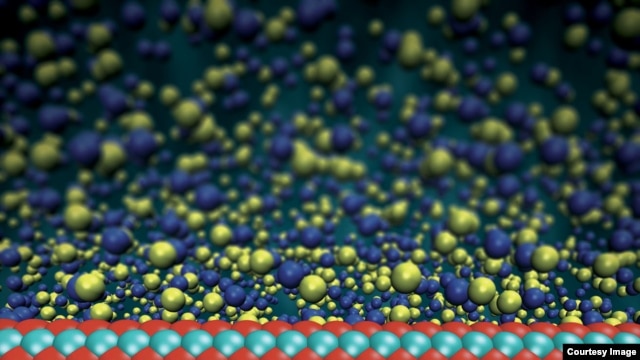News / Science & Technology
Osmosis - the Next Big Step for Clean Energy?
a molybdenum 3 atoms thick selective membrane © Steven Duensing / National Center for Supercomputing Applications, University of Illinois, Urbana-Champaign
July 13, 2016 1:21 PM
Solar Power is becoming increasingly inexpensive, and efficient. The same goes for wind power, but a natural limitation of both systems is that on some days the sun doesn't shine, and on some days, the wind doesn't blow.
But researchers at the Ecole Polytechnique Fédérale de Lausanne (EPFL) say they have found a simple way to produce a lot of energy, anywhere a river meets the sea.
Their work is being published in the journal Nature and it's an incredibly simple and straightforward idea that uses osmosis to create energy.
Osmosis occurs when salty water hits fresh water across a permeable membrane. Salt ions (atom with an electrical charge) will pass through the membrane until the amount of salt is equal on both sides. Pretty simple.
WATCH: EPFL video
WATCH: EPFL video
Catch a charge
The researchers wondered if they could figure out how to capture that electrical charge as it moved across the membrane separating the fresh and salty water. They did it by creating two tiny membranes, just three atoms thick, made of molybdenum disulfide, which is plentiful and easy to produce. Then they made a tiny hole in the membranes and let osmosis take over and push the electrically charged salt ions through this nanopore.
What makes this unique is that the nanopore lets positively charged ions through, while keeping out most of the negatively charged ions. A generator attached to the membrane collects this energy. It sounds simple, but the researchers say it just seems that way.
"We had to first fabricate and then investigate the optimal size of the nanopore. If it's too big, negative ions can pass through and the resulting voltage would be too low. If it's too small, not enough ions can pass through and the current would be too weak," said Jiandong Feng, lead author of the research. Getting that nanopore just right is the big news.
Pure energy
The researchers say a one meter square membrane with nanopores across about 30 percent of its space could produce one megawatt of energy, enough to light 50,000 standard energy efficient light bulbs.
But it isn't easy to drill a nanopore in a three atom thick membrane, and standardizing that process is going to take much more work.
"We can control with sub-nanometer precision pore size when we work with the single nanopore," Aleksandra Radenovic, one of the researchers told VOA. "To scale the process and have millions or trillions of pores, that would require a different nanopore fabrication process."
But according to Radenovic that's exactly what they're working on now. If they can standardize the process of creating these nanopore filled membranes it just might be possible to create huge amounts of energy all the time, wherever salty and fresh water mix.


No comments:
Post a Comment